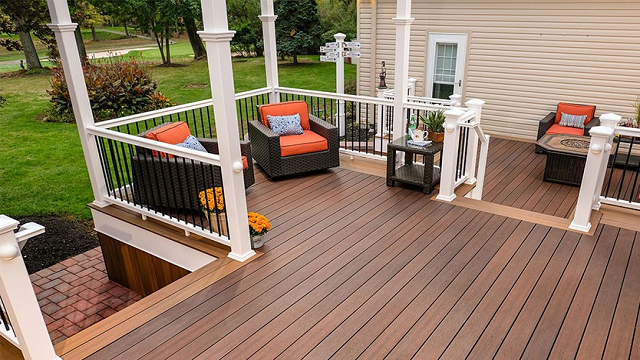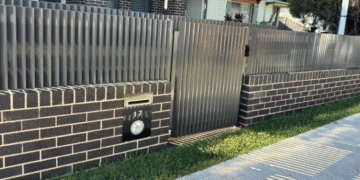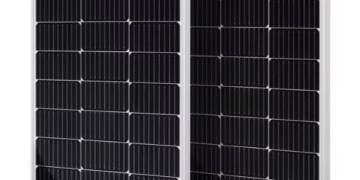Homeowners in Canada are increasingly turning to PVC decking for their outdoor living spaces. This revolutionary material offers durability, low maintenance, and aesthetic appeal, making it an ideal solution for decks.
Unlike traditional decking materials, vinyl decking is made from a polyvinyl chloride (PVC) system that forms an extremely durable, resilient, and waterproof material. This means it requires minimal maintenance, resists UV damage, and provides a long-lasting solution for outdoor areas.
The benefits of vinyl decking are numerous, including its resistance to rot, mold, and mildew, making it a cost-effective and environmentally friendly choice for Canadian homeowners.
Understanding Vinyl Decking Systems
Understanding the components of vinyl decking is crucial for homeowners looking to upgrade their outdoor spaces. Vinyl decking systems are designed to provide a durable and aesthetically pleasing outdoor living area, and their composition plays a significant role in their performance.
What Makes Up a Vinyl Deck
A vinyl deck is composed of multiple layers, each serving a specific purpose. The structural base layer provides the foundation, while the middle layer ensures water resistance, and the top layer incorporates UV protection and slip-resistant texturing. These layers work together to create a waterproof membrane that protects both the deck’s surface and the underlying structure from moisture damage.
Different Types of Vinyl Decking Materials
Various types of vinyl decking materials are available in the market, catering to different needs and preferences. For instance, Duradek is a popular vinyl decking material that was introduced in 1974 as a waterproof membrane for flat roofs and rooftop decks. It serves a dual purpose as both a roofing membrane and a walkable surface. Duradek comes in 27 stylish finishes, ensuring a perfect match for any home or commercial property.
- Durable and long-lasting
- Resistant to rot, mold, and mildew
- Aesthetically versatile with multiple finish options
How Vinyl Decking Compares to Other Materials
When compared to other decking materials, vinyl decking stands out for its durability, low maintenance requirements, and resistance to rot, mold, and mildew. Unlike traditional wood decking, vinyl decking does not require frequent staining or sealing, making it a convenient choice for homeowners.
- Vinyl decking is more durable than traditional wood decking.
- It requires less maintenance than wood or composite decking.
- Vinyl decking is resistant to moisture damage, reducing the risk of rot and mildew.
In conclusion, vinyl decking systems offer a robust and attractive solution for outdoor living spaces. By understanding the composition and types of vinyl decking materials, homeowners can make informed decisions about their decking needs.
The Advantages of Installing Vinyl Decking
Installing vinyl decking can be a game-changer for homeowners looking for a low-maintenance outdoor solution. Vinyl decking is made from a polyvinyl chloride (PVC) system, forming an extremely durable, resilient, and waterproof material ideal for outdoor living spaces.
One of the most significant advantages of vinyl decking is its low maintenance requirement. Unlike traditional wood decking, which demands regular staining and sealing, vinyl decking needs minimal upkeep. A simple cleaning with soap and water is typically sufficient to maintain its appearance and functionality.
Vinyl decking is also renowned for its durability and long-lasting nature. With proper care, it can last beyond 20 years, making it a cost-effective solution in the long run. Its resistance to UV radiation, mold, and mildew ensures that it remains in good condition even when exposed to harsh weather conditions.
Furthermore, vinyl decking offers a slip-resistant surface, making it a safe choice for families and individuals alike. This feature, combined with its durability, makes vinyl decking an attractive option for those looking to create a comfortable and safe outdoor living space.
- Low maintenance requirements
- Durable and long-lasting
- Resistant to UV radiation, mold, and mildew
- Slip-resistant surface
For homeowners seeking both style and structural safety, deck railings Edmonton offer a wide variety of vinyl options that complement any decking system while withstanding Alberta’s harsh climate.
Cost Considerations for Vinyl Decking Projects
Vinyl decking, while potentially more expensive upfront, offers long-term cost savings that make it a financially savvy choice. When considering a vinyl decking project, it’s essential to understand the various cost factors involved.
Material Costs in Canadian Markets
The cost of vinyl decking materials in Canada can vary based on the quality, brand, and type of material chosen. On average, homeowners can expect to pay between $30 to $60 per square foot for high-quality vinyl decking materials.
Installation Expenses and Labour Fees
Installation costs for vinyl decking can significantly impact the overall expense. Labour fees vary by region and contractor, but on average, Canadians can expect to pay between $20 to $40 per square foot for professional installation.
Factors influencing installation costs include:
- Complexity of the deck design
- Size of the deck
- Local labour rates
Long-term Value Assessment
While the initial cost of vinyl decking may be higher than traditional materials, its durability and low maintenance requirements provide significant long-term savings. Vinyl decking can last up to 25 years or more with proper care, reducing the need for frequent replacements.
The long-term benefits of vinyl decking include:
- Reduced maintenance costs over time
- Extended lifespan compared to traditional decking materials
- Protection of the underlying structure, potentially reducing costly repairs
By considering both the upfront costs and the long-term value, homeowners can make an informed decision about whether vinyl decking is the right choice for their outdoor space.
Essential Maintenance and Care Tips
To keep your vinyl decking looking its best, regular maintenance is crucial. Proper care ensures the longevity and performance of your deck, maintaining its appearance and functionality over time.
Regular cleaning is one of the simplest ways to maintain your vinyl decking. Dirt and debris can accumulate, causing the deck to look dull and worn. Cleaning your vinyl decking at least once a year is recommended to remove dirt and grime.
Seasonal Cleaning Guidelines
Cleaning your vinyl decking seasonally can be done with mild soap and water. Mix a solution of soap and warm water, and use a soft-bristled brush or a mop to clean the deck surface. Rinse thoroughly with clean water to remove any soap residue.
- Spring: Remove winter debris and dirt with a gentle cleaning solution.
- Summer: Regularly sweep the deck to prevent dirt accumulation.
- Fall: Clean leaves and debris to prevent staining and damage.
- Winter: Avoid using harsh chemicals or abrasive cleaners that can damage the vinyl.
Damage Prevention Strategies
Preventing damage to your vinyl decking is just as important as cleaning it. Avoid using harsh chemicals or abrasive cleaning tools that can scratch or discolor the vinyl. Also, be mindful of heavy furniture or objects that can cause scratches or dents.
Professional Maintenance Services
While vinyl decking is designed to be low maintenance, occasional professional maintenance services may be necessary. Professionals can inspect the deck, address any potential issues, and perform repairs or re-caulking as needed.
By following these care tips and maintenance guidelines, you can enjoy your vinyl decking for years to come, maintaining its appearance and functionality.
Conclusion: Making the Right Choice for Your Outdoor Space
Vinyl decking represents a sophisticated solution for modern outdoor living spaces, offering an impressive combination of durability, low maintenance, and aesthetic appeal. With its extensive design options, UV protection, and environmental sustainability features, vinyl decking is an increasingly popular choice for those seeking a high-quality, low-maintenance decking material.
The benefits of vinyl decking, including its resistance to rot, mold, and mildew, make it an ideal PVC decking solution for Canadian homeowners. By considering the benefits, costs, and maintenance requirements of vinyl decking, homeowners can make an informed decision and transform their outdoor space into a functional, stylish, and worry-free retreat for years to come.
Whether for residential or commercial applications, vinyl decking offers a reliable and long-lasting solution. Its numerous vinyl decking benefits make it a superior choice for outdoor living spaces, providing a durable and low-maintenance alternative to traditional decking materials.
FAQ
What is vinyl decking made of?
Vinyl decking is made from a polyvinyl chloride (PVC) system that forms an extremely durable, resilient, and waterproof material.
How many layers does vinyl decking typically have?
Vinyl decking typically consists of multiple layers, including a structural base layer, a middle layer for water resistance, and a top layer that incorporates UV protection and slip-resistant texturing.
What are the benefits of using vinyl decking?
Vinyl decking offers numerous benefits, including durability, low maintenance requirements, resistance to UV damage, mold, and mildew, and aesthetic appeal.
How do I maintain my vinyl decking?
Regular cleaning with soap and water is typically sufficient to maintain the appearance and functionality of vinyl decking. Seasonal cleaning is also recommended to remove dirt and debris.
Can vinyl decking be damaged?
While vinyl decking is designed to be durable, it can be damaged by harsh chemicals, abrasive cleaning tools, and other factors. Damage prevention strategies, such as avoiding these hazards, are crucial.
How long does vinyl decking last?
Vinyl decking is durable and long-lasting, with a lifespan that can extend beyond 20 years with proper care.
What is the cost of vinyl decking in Canadian markets?
The material costs of vinyl decking in Canadian markets can vary depending on the type and quality of the vinyl decking material. Installation expenses and labour fees also play a crucial role in the overall cost.
Is vinyl decking a cost-effective option?
Although the initial investment in vinyl decking might be higher, the cost savings over time due to minimal maintenance needs, extended durability, and the protection of the underlying structure make it a cost-effective choice in the long run.
Are there different types of vinyl decking materials available?
Yes, different types of vinyl decking materials are available, such as Duradek, which comes in 27 stylish finishes, ensuring a perfect match for any home or commercial property.
How does vinyl decking compare to other decking materials?
Vinyl decking stands out for its durability, low maintenance requirements, and resistance to rot, mold, and mildew, making it a superior choice compared to other decking materials.
Is vinyl decking environmentally friendly?
Yes, vinyl decking is an environmentally friendly choice due to its minimal maintenance requirements, extended durability, and the protection of the underlying structure, reducing the need for frequent repairs and replacements.













